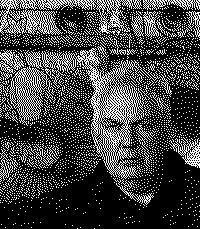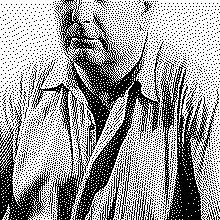Artists/Alexander Calder
Fast Facts
Invention of the Mobile
Calder is perhaps best known for inventing the mobile, a type of kinetic sculpture that balances and moves with air currents. These delicate, floating sculptures marked a significant development in the realm of abstract sculpture.
Early Work and Circus Theme
Before his mobiles, Calder created wire sculptures and was famous for his miniature "Cirque Calder," a complex and whimsical circus made from wire, fabric, and other materials. This work displayed his extraordinary skill in bending and twisting wire to create dynamic figures.
Abstract Sculptures
Apart from mobiles, Calder also created 'stabiles' – large, static sculptures often made of bolted sheet metal. These works, while stationary, still evoke a sense of movement and fluidity.
Use of Color and Form
Calder's sculptures are notable for their playful use of color and organic forms. His works often feature bold primary colors and are characterized by their curved, flowing lines and abstract shapes.
Engineering Background
His formal education in mechanical engineering greatly influenced his artistic technique, particularly in the balance and motion of his sculptures.
Biography



Alexander Calder, born on July 22, 1898, in Lawnton, Pennsylvania, was an innovative American sculptor and artist famed for inventing the mobile, a type of kinetic sculpture, and significantly influencing the course of modern art.
Calder's lineage was steeped in artistry; his grandfather, Alexander Milne Calder, was a notable sculptor, and his father, Alexander Stirling Calder, followed in these footsteps, creating many public sculptures. His mother, a professional portrait artist, had studied in Paris, marking the family's artistic pedigree and international connections from an early age. Calder's early exposure to art, including modeling for his father's sculptures and creating his first works as a child, underscored a creative spirit that would define his career (Wikipedia).
Opting initially for a path distinct from his artistic lineage, Calder pursued mechanical engineering at Stevens Institute of Technology, graduating in 1919. This choice was influenced not by a passion for engineering but rather by an admiration for a friend in the field. Nonetheless, Calder's engineering skills profoundly influenced his artistic work, particularly in the mechanics of his mobiles and stabiles. Post-college, Calder held various jobs, including positions as a hydraulic engineer and a draughtsman, before sailing to Guatemala, an experience that would ignite his desire to pursue art full-time. Upon his return to New York, Calder began his formal art education, attending classes at the Art Students League and interacting with the city's vibrant arts scene (Wikipedia).
Calder's artistic breakthrough came after he moved to Paris in the 1920s, where he became an integral part of the avant-garde community, mingling with artists like Joan Miró, Marcel Duchamp, and Fernand Léger. It was during this period that Calder developed his Cirque Calder, a miniature circus that exemplified his interest in movement and would foreshadow his invention of the mobile. Duchamp, struck by the kinetic aspect of Calder's works, coined the term "mobiles" for them. The mobiles' capacity for movement without motors, using air currents instead, was a revolution in sculpture, allowing for the element of chance in their movement. Calder also produced static sculptures, termed "stabiles" by Jean Arp, which further explored his interest in dynamic forms and monumental scale (The Art Story) (Calder Foundation).
Calder's return to the United States in 1933 marked the beginning of a prolific period in which he expanded his work into large-scale sculptures and public art installations, including iconic works for Expo '67 in Montreal and other significant public and private collections. Throughout his life, Calder continued to innovate, exploring new mediums and techniques, including jewelry, tapestries, and set design for ballet and theater (The Art Story) (Calder Foundation).
Alexander Calder's legacy is profound, not only in the field of sculpture but also in the broader context of modern art. His work bridged the gap between abstract art and everyday life, bringing movement, color, and whimsy into the public sphere and the natural environment. Calder's influence can be seen in the works of numerous artists across various disciplines, reflecting his role in shaping the direction of 20th-century art. He passed away on November 11, 1976, in New York, leaving behind a vast and impactful body of work that continues to inspire and captivate audiences worldwide (Wikipedia) (The Art Story) (Calder Foundation).
Importance
Alexander Calder's importance in the realm of art is monumental and multifaceted, reflecting his innovative spirit and his contributions to modern sculpture and kinetic art.
Invention of the Mobile
Calder is renowned for inventing the mobile, a type of kinetic sculpture that moves in response to air currents, viewer interaction, or motor activation. These creations broke away from traditional, static sculptures by incorporating the elements of movement and balance, bringing a dynamic aspect to sculpture that had not been explored in such depth before. His mobiles, varying from delicate, intimate pieces to grandiose, ceiling-suspended works, invite a viewer's interaction and perception, making each encounter with a Calder piece a unique experience (MOMA).
Integration of Art and Engineering
With a background in mechanical engineering, Calder applied his understanding of mechanics and materials to art, creating works that were not only visually compelling but also marvels of engineering. His ability to harmonize technical skill with artistic vision enabled him to pioneer the genre of kinetic art, influencing the direction of modern sculpture (MOMA).
Pioneering Kinetic Art
Calder's work paved the way for kinetic art, a movement that emphasizes change and motion in art. By creating sculptures that moved and evolved with their environment, he introduced a new way of experiencing art, one that involved change and the element of surprise. His work laid the groundwork for future artists interested in creating art that extends beyond static forms to engage with time, space, and the physics of the real world (The Art Story) (MOMA).
Contributions to Public Art
Calder's significance extends into the public realm through his creation of monumental stabiles and mobiles for public spaces around the world. His commitment to creating art for public enjoyment and engagement contributed to the proliferation of public art in the 20th century. These large-scale works, such as those commissioned for the New York Port Authority and UNESCO in Paris, not only enhance public spaces but also democratize access to art by making it a part of everyday life (The Art Story).
Legacy and Influence
Calder's innovative approach to sculpture and his exploration of form, balance, and color have left a lasting legacy, influencing generations of artists. From the Abstract Expressionists who drew inspiration from the gestural qualities of his mobiles, to kinetic artists and performers who found new ways to engage audiences through motion and interaction, Calder's influence permeates a wide range of artistic movements and practices. His work continues to inspire artists, designers, and architects, cementing his place as a pivotal figure in 20th-century art (The Art Story).
Technique
Alexander Calder's artistic technique and its impact on the art world are distinctive and influential, marked by several pivotal approaches and innovations:
Innovative Use of Wire as a Medium
Calder transformed wire sculpting into a form of drawing in space, creating three-dimensional line drawings that depicted figures, animals, and later evolved into more abstract forms. This technique allowed him to explore the interplay between form and void, balance and movement, laying the groundwork for his later kinetic sculptures (Artsy).
Creation of Kinetic Sculptures
Calder is celebrated for pioneering kinetic art with his mobiles—sculptures that move with air currents, motors, or by viewer interaction. This introduced a dynamic element to sculpture, where movement and change became integral parts of the artwork, engaging viewers in a continuously evolving experience (MOMA).
Integration of Engineering and Art
With a background in mechanical engineering, Calder brought a unique perspective to art that blended precision engineering with aesthetic beauty. This combination enabled him to create complex mobiles that balanced meticulously, showcasing his ability to fuse technical skill with artistic vision (MOMA).
Exploration of Large-Scale Public Sculptures
Calder's work in public spaces introduced art into everyday life, enhancing public areas with monumental sculptures that interacted with their surroundings. His stabiles, large stationary sculptures, contributed to the proliferation of public art, making art accessible and part of the communal experience (The Art Story) (Artsy).
Active Engagement with Viewer Perception
Calder's artworks are designed to engage the viewer actively, with their movement and form depending on the viewer's perspective and interaction. This approach invites viewers to become part of the creative process, experiencing the artwork in a personal and dynamic way (MOMA).
















